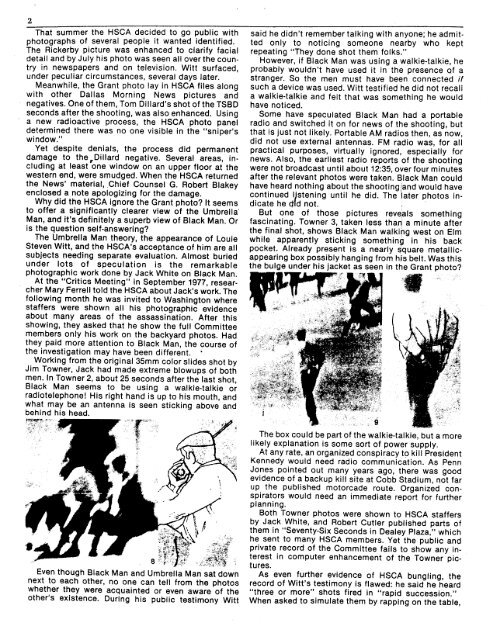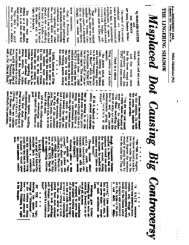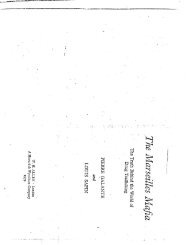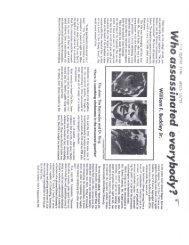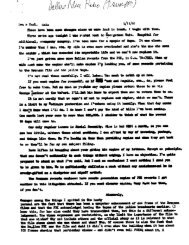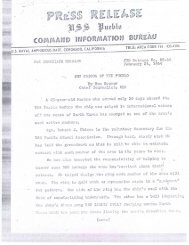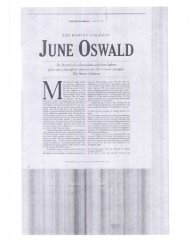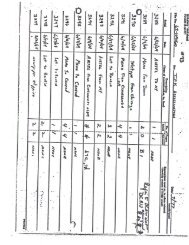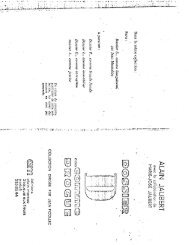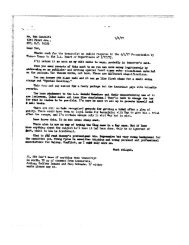coverups! - The Harold Weisberg Archive
coverups! - The Harold Weisberg Archive
coverups! - The Harold Weisberg Archive
Create successful ePaper yourself
Turn your PDF publications into a flip-book with our unique Google optimized e-Paper software.
2<br />
That summer the HSCA decided to go public with<br />
photographs of several people it wanted identified.<br />
<strong>The</strong> Rickerby picture was enhanced to clarify facial<br />
detail and by July his photo was seen all over the country<br />
in newspapers and on television. Witt surfaced,<br />
under peculiar circumstances, several days later.<br />
Meanwhile, the Grant photo lay in HSCA files along<br />
with other Dallas Morning News pictures and<br />
negatives. One of them, Tom Dillard's shot of the TSBD<br />
seconds after the shooting, was also enhanced. Using<br />
a new radioactive process, the HSCA photo panel<br />
determined there was no one visible in the "sniper's<br />
window."<br />
Yet despite denials, the process did permanent<br />
damage to the ,Dillard negative. Several areas, including<br />
at least one window on an upper floor at the<br />
western end, were smudged. When the HSCA returned<br />
the News' material, Chief Counsel G. Robert Blakey<br />
enclosed a note apologizing for the damage.<br />
Why did the HSCA ignore the Grant photo? It seems<br />
to offer a significantly clearer view of the Umbrella'<br />
Man, and it's definitely a superb view of Black Man. Or<br />
is the question self-answering?<br />
<strong>The</strong> Umbrella Man theory, the appearance of Louie<br />
Steven Witt, and the HSCA's acceptance of him are all<br />
subjects needing separate evaluation. Almost buried<br />
under lots of speculation is the remarkable<br />
photographic work done by Jack White on Black Man.<br />
At the "Critics Meeting" in September 1977, researcher<br />
Mary Ferrell told the HSCA about Jack's work. <strong>The</strong><br />
following month he was invited to Washington where<br />
staffers were shown all his photographic evidence<br />
about many areas of the assassination. After this<br />
showing, they asked that he show the full Committee<br />
members only his work on the backyard photos. Had<br />
they paid more attention to Black Man, the course of<br />
the investigation may have been different. •<br />
Working from the original 35mm color slides shot by<br />
Jim Towner, Jack had made extreme blowups of both<br />
men. In Towner 2, about 25 seconds after the last shot,<br />
Black Man seems to be using a walkie-talkie or<br />
radiotelephone! His right hand is up to his mouth, and<br />
what may be an antenna is seen sticking above and<br />
behind his head.<br />
Even though Black Man and Umbrella Man sat down<br />
next to each other, no one can tell from the photos<br />
whether they were acquainted or even aware of the<br />
other's existence. During his public testimony Witt<br />
8<br />
said he didn't remember talking with anyone; he admitted<br />
only to noticing someone nearby who kept<br />
repeating "<strong>The</strong>y done shot them folks."<br />
However, if Black Man was using a walkie-talkie, he<br />
probably wouldn't have used it in the presence of a<br />
stranger. So the men must have been connected if<br />
such a device was used. Witt testified he did not recall<br />
a walkie-talkie and felt that was something he would<br />
have noticed.<br />
Some have speculated Black Man had a portable<br />
radio and switched it on for news of the shooting, but<br />
that is just not likely. Portable AM radios then, as now,<br />
did not use external antennas. FM radio was, for all<br />
practical purposes, virtually ignored, especially for<br />
news. Also, the earliest radio reports of the shooting<br />
were not broadcast until about 12:35, over four minutes<br />
after the relevant photos were taken. Black Man could<br />
have heard nothing about the shootingand would have<br />
continued listening until he did. <strong>The</strong> later photos indicate<br />
he did not.<br />
But one of those pictures reveals something<br />
fascinating. Towner 3, taken less than a minute after<br />
the final shot, shows Black Man walking west on Elm<br />
while apparently sticking something in his back<br />
pocket. Already present is a nearly square metallicappearing<br />
box possibly hanging from his belt. Was this<br />
the bulge under his jacket as seen in the Grant photo?<br />
<strong>The</strong> box could be part of the walkie-talkie, but a more<br />
likely explanation is some sort of power supply.<br />
At any rate, an organized conspiracy to kill President<br />
Kennedy would need radio communication. As Penn<br />
Jones pointed out many years ago, there was good<br />
evidence of a backup kill site at Cobb Stadium, not far<br />
up the published motorcade route. Organized conspirators<br />
would need an immediate report for further<br />
planning.<br />
Both Towner photos were shown to HSCA staffers<br />
by Jack White, and Robert Cutler published parts of<br />
them in "Seventy-Six Seconds in Dealey Plaza," which<br />
he sent to many HSCA members. Yet the public and<br />
private record of the Committee fails to show any interest<br />
in computer enhancement of the Towner pictures.<br />
As even further evidence of HSCA bungling, the<br />
record of Witt's testimony is flawed: he said he heard<br />
"three or more" shots fired in "rapid succession."<br />
When asked to simulate them by rapping on the table,<br />
9


